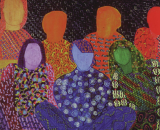Article
Medea Benjamin & Maria Luisa Mendonça
How did you become involved in the PT? From its very beginnings, the PT understood the need to be as broad based as possible. Its strongest base of support was the unions and the workers' movement in general, but it also received the backing of the progressive wing of the Catholic church.
Fred Rosen & Mario Murillo
Dr Jagan, you've been referred to in the U.S.
Ben Kohl & Linda Farthing
How would you describe the current situation of the coca growers movement in Bolivia? We are focusing on how the government violates its own laws as well as the agreements that they have signed with us. For example, we have mobilized against Law 1008 which controls coca produc- tion, because the law is unjust.
The components of democratic citizenship do not easily coexist with extreme and persistent inequality. Rather, they tend to get distorted in ways that pose serious problems for the practice of democracy.
Why has there been a need to rebuild the left in Argentina? The left in Latin America was never really in con- tact with the masses, especially in Argentina. There were two great parties that were the axes of politics and builders of the state in Argentina.
Over the past year and especially in recent months, there have been a series of nationwide strikes against the Haitian government's plans to privatize public enterprises and to implement the structural adjustment program that the World Bank and the International Monetary Fund are prescribing for Haiti. What's going on? In January, dozens of groups organized a strike against the economic reforms.
Tell us something about the trajectory of the trade-union movement and the broader popular movement since the end of the dictatorship. The criminal and terrorist repression of the dicta- torship meant not only the murder of many social and labor leaders, but also the virtual destruction of the powerful social movement in existence at the time.
Carollee Bengelsdorf & Carmen Diana Deere
You have spoken about the possibility of Cuba maintain- ing some level of planning. How do you understand the difference between the Cuban planning process now and the planning before the crisis? In its most general sense, planning is society's ability to prioritize certain objectives over others and thereby to regulate its development politically.
What are the goals of the AFL-CIO today? Our main goal is to reinvigorate the U.S.
Comparing the Workers Party (PT) today and ten years ago, would you say that the PT is gaining or losing strength in Brazil? I would say that the PT is gaining strength. If you analyze the election results, the PT has grown after each election since its founding in 1980.
What is Casa Alternativa Joven? bout four years ago, a group of young people who were involved in community youth groups in Villa El Salvador founded Casa Alternativa Joven. Hundreds of youth groups have existed through- out the district since the 1970s, and they have done interesting things like organize sports tournaments, musical groups, theater groups, etc.
You are spearheading a drive to bring the question of Latin America's foreign debt before the International Court of Justice. What is that all about? We may go to the International Court of Justice or we may bring a case involving a U.
What is the state of the independence movement today in Puerto Rico? How would you define its position? There are now about 15 different independence groups, most of which cooperate under the aegis of an umbrella group called the Hostos National Congress. There is also a nationalist electoral move- ment in Puerto Rico, although I personally don't believe in the efficacy of the electoral process because it is not possible to have democratic elections in a colony.
Mario Murillo & Victoria Maldonado
The Colombian government has repeatedly stated that the FARC is no longer a political force, but a band of armed thugs involved in extortion and drug trafficking. Even a group of respected intellectuals from the Colombian left has recently published an open letter crit- icizing the guerrillas for no longer having a political- ideological program.
What has the recent signing of the Peace Accords between the government and the Guatemalan National Revolutionary Unity (URNG) guerrilla movement meant for you? As women who were victims of the armed con- flict, we believe that this is an opportunity to promote the participation of all sectors of soci- ety. The Peace Accords only provide general guide- lines for the construction of a different state.
Fred Rosen & Jo-Marie Burt
Don Samuel Ruiz, the Catholic Bishop of Chiapas, has long been associated with the theology of liberation and the Church's "option for the poor." He has been an articulate spokesperson for the grievances of southern Mexico's indigenous poor, and since the uprising of the Zapatista Army of National Liberation (EZLN) on January 1, 1994, he has played a key role in the mediation of the conflict between the Zapatista rebels and the Mexican government.
How has the women's movement developed in Nicaragua? he women's movement in Nicaragua is today one of the strongest and most purposeful social movements in the country. It is also the strongest women's movement in Central America.
The left has always been fundamentally optimistic. Its critiques of the state of things have always con- tained an implicit celebration of the world as it could be.


